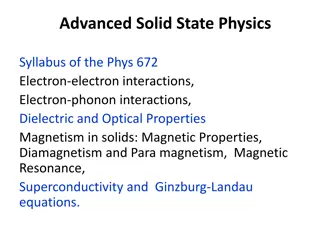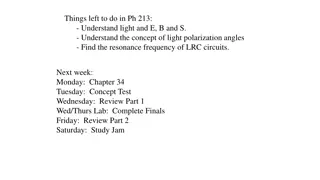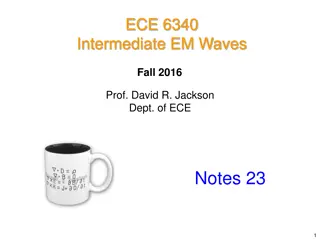Electromagnetic Waves: Maxwell's Contributions and Hertz's Observations
James Clerk Maxwell's groundbreaking work in the 19th century revealed the fundamental nature of light as an electromagnetic wave. His equations formed the basis for understanding the interplay between electricity and magnetism, predicting the existence of electromagnetic waves. Heinrich Hertz furth
6 views • 24 slides
Electromagnetic Surveying Methods and Applications
Electromagnetic surveying, conducted by Dr. Laurent Marescot, utilizes various methods like resistivity, induced polarization, and high-frequency techniques for exploration and investigation purposes. The electromagnetic method involves generating primary fields and detecting secondary fields to ana
4 views • 55 slides
Agricultural Materials Behavior under Stress
Agricultural materials exhibit different behaviors under stress, which can be represented by models such as Maxwell, Kelvin, and Burger's models. The laboratory method for determining creep in a 4-element Burger's model is explained. Additionally, the drying process of agricultural materials, includ
1 views • 4 slides
Maxwell Equations in Thermodynamics
In thermodynamics, Maxwell equations are derived using Euler's reciprocity relation. They involve characteristic functions such as internal energy, free energy, enthalpy, and Gibbs free energy, along with parameters like temperature, entropy, pressure, and volume. These equations form the foundation
1 views • 15 slides
Fundamentals of Thermodynamic Property Relations
Determining thermodynamic properties is crucial for analysis, involving direct and derived properties expressed through formulations and relations. Partial derivatives, fundamental relations like the 1st and 2nd laws, and functions such as enthalpy, Helmholtz, and Gibbs are explored. Maxwell relatio
5 views • 56 slides
Insight into Kinetic Theory of Gases and Maxwell Velocity Distribution
The discussion delves into the kinetic theory of gases, highlighting the deviations from ideal gas behavior and the derivation of the Maxwell velocity distribution. It explores the intricacies of molecule-wall collisions, Maxwell's assumptions, the Gaussian distribution, and the concept of reversibl
0 views • 8 slides
Journey Through Optics: From Ancient Discoveries to Modern Applications
Explore the fascinating history of optics, from the pioneering work of Alhazen in the Middle Ages to the revolutionary experiments of Newton, Young, and Maxwell in the 18th and 19th centuries. Discover how the wave-particle duality of light has shaped our understanding of optics and led to groundbre
5 views • 14 slides
Improving Prescribing Safety in Medical Practice
Professor Simon Maxwell's Prescribing Safety Assessment (PSA) aims to address concerns regarding junior doctors' readiness for prescribing medications. The assessment was developed in response to high error rates in prescribing, emphasizing the importance of safe medication practices to enhance pati
1 views • 43 slides
Complex Wavevectors in Homogeneous Media
Exploring the concept of complex wavevectors in a homogeneous medium, this content delves into monochromatic waves, Maxwell equations, wave propagation, and the relationship between material properties and wave behavior. It discusses how the complex nature of wavevectors impacts fields, damping, and
0 views • 17 slides
General Plane Waves in Electromagnetic Theory
This study focuses on the analysis of general plane waves in electromagnetic theory, covering topics such as the general form of plane waves, Helmholtz equation, separation equation, wavenumber vector, Maxwell's equations for plane waves, and the symbolic representation of plane waves. The content d
0 views • 41 slides
Geometric Algebra and Calculus: A Deep Dive into Vector Derivatives and Maxwell Equations
Explore the world of geometric algebra and calculus through topics such as vector derivatives, Cauchy-Riemann equations, Maxwell equations, and spacetime physics. Unify diverse mathematical concepts to gain insights into analytic functions, differential operators, and directed integration.
0 views • 20 slides
Insights on Resilient Leadership: Qualities and Inspiration
Resilient leadership involves influencing, inspiring, and guiding others towards shared goals. Key qualities include confidence, charisma, commitment, and character. Leaders with inner strength can inspire and motivate their teams effectively. Quotes from renowned leaders like John C. Maxwell and Ma
0 views • 27 slides
Introduction to Drude Model in Solid State Physics
Drude Model, formulated around 1900, explains the fundamental properties of metals such as electricity and heat. It proposes that electrons in metals behave like a classical electron gas, moving freely between atomic cores. The model considers the mean free path between electron collisions and estim
1 views • 39 slides
E and B Fields in Physics 213
Explore concepts such as light polarization angles, resonance frequency of LRC circuits, Lorentz Force Law, Gauss Law, Faraday's Law, and Ampere-Maxwell Law in Physics 213. Delve into the interplay between electric and magnetic fields, and their effects on charged particles such as electrons and pro
0 views • 19 slides
A Comparative Analysis of "The Girls in Their Summer Dresses" Versions
A comparison between the original version of "The Girls in Their Summer Dresses" by Shaw and the Maxwell-edited version published in The New Yorker. Shaw's account of the composition process and Maxwell's editing are discussed, offering insights into the impact of editing on the final publication.
1 views • 6 slides
Thermodynamics: Laws and Maxwell's Demon
Explore the laws of thermodynamics including the first, second, and third laws, and Maxwell's Demon thought experiment challenging the second law. Learn how entropy and energy are fundamental concepts in thermodynamics.
1 views • 18 slides
The Epistemological Problem of Thought Experiments in Science
Explore the epistemological challenge of how thought experiments lead to new scientific knowledge, illustrated through examples like Maxwell's Demon. Delve into the clash between thermodynamics and molecular kinetic theory, questioning the applicability of our macroscopic experiences at the microsco
1 views • 55 slides
The Role of the HCT/P Work Group in Educating the UDI Community
The LUC Human Cells, Tissue, and Cellular and Tissue-based Products (HCT/P) work group, led by co-chairs Paul Ashford and Denise Maxwell-Downing, aims to develop educational materials and guidance documents regarding the tracking of medical devices containing HCT/Ps. This group consists of stakehold
0 views • 38 slides
Electromagnetic Waves and Their Velocity
Light, as a transverse wave, is a part of the electromagnetic spectrum produced by accelerating electrons. Electromagnetic waves originate from vibrating charges, creating a continuous cycle of electric and magnetic fields. The velocity of electromagnetic waves is constant due to energy conservation
1 views • 32 slides
Indiana 2024 Summer Convention Memorial Service
Pay tribute to the brave individuals from H.I. Bearss Detachment, Calumet Detachment, Howlin Mad Detachment, St. Joseph Valley Detachment, and Whitewater Valley Detachment who have passed away, honoring their service and sacrifices. The Department Chaplain, Ernie Maxwell, leads the memorial service,
0 views • 29 slides
Project Management Office Updates and Important Information
The Project Management Office, led by Project Director Susan Maxwell, is overseeing various projects including the Online Admissions Application, Asset Tracking, and Budget Planning Tool. Key updates include course building for summer and fall, user acceptance testing across departments, and buildin
0 views • 10 slides
The Journey of James Clerk Maxwell: From Curious Child to Pioneer of Electromagnetism
James Clerk Maxwell, born in 1831, showed early signs of brilliance and curiosity. Despite facing obstacles in his education, he excelled in math and physics, eventually making groundbreaking discoveries in electromagnetism. Maxwell's work laid the foundation for modern physics and his legacy contin
1 views • 7 slides
Mathematical Insights into Surface Plasmon Polaritons
This mathematical explanation delves into the intricacies of surface plasmon polaritons, covering Maxwell's equations, wavenumbers, bulk and surface plasmon-polariton formulations, medium considerations, excitation conditions, losses, and matching examples with air, gold, and sapphire prisms. Detail
0 views • 13 slides
Molecular Speed Distribution in Thermal Physics
Exploring the distribution of molecular speeds in gases at different temperatures through the Maxwell-Boltzmann speed distribution law. This lecture covers the concepts of probability distribution functions for speed intervals, comparison of speed distributions at varying temperatures, and calculati
0 views • 22 slides
Light Wave Polarization and Brewster's Law
Interference and diffraction phenomena demonstrate light as wave motion, leading to insights on wave nature. Maxwell's electromagnetic theory supports light as transverse waves. Learn about polarization of light waves, production methods, and applications in industry. Explore the discovery of light
0 views • 89 slides
Electromagnetic Waves in Physics
Exploring the propagation of electromagnetic waves in different mediums such as free space and isotropic dielectrics. Discusses Maxwell's equations, wave equations, transverse nature, energy transmission, and impedance in electromagnetic wave propagation.
0 views • 24 slides
Insights into the Life and Achievements of Albert Einstein
Albert Einstein, born in 1879 in Germany, is renowned for his groundbreaking work in physics, particularly his theory of General Relativity and Special Relativity. Beyond these accomplishments, he also delved into research on photoelectric effects and thermodynamics, receiving a Nobel Prize for his
0 views • 8 slides
Exploring the Quest for Aether: A Journey through Relativity and Failure
Delve into the intriguing topics of special relativity, James Clerk Maxwell's equations, the concept of aether, and the groundbreaking Michelson-Morley Experiment. Witness the evolution of scientific understanding and the ultimate failure of the stationary aether hypothesis.
0 views • 32 slides
Maxwell's Equations and Vector Potentials
Significance of Maxwell's full equations, effects of time-varying fields and sources, gauge choices, Green's function for vector and scalar potentials, and formulation of Maxwell's equations in terms of vector and scalar potentials. Delve into the essence of electromagnetism with detailed insights i
0 views • 24 slides
Duality in Maxwell's Equations and Radiation from Magnetic Current
In the study of electromagnetic waves, duality in Maxwell's equations plays a crucial role in understanding the symmetry between electric and magnetic fields. This concept allows us to find the radiation emitted from a magnetic current by considering a dual problem with an electric current source. B
0 views • 23 slides
Maxwell's Equations and Spherical Currents
In the realm of physics, Maxwell's equations hold significant importance, especially in understanding the interplay between electricity and magnetism. Delve into the intricate concepts behind Gauss's laws, Faraday's law of induction, and Ampère's law in relation to spherical currents and magnetic f
0 views • 30 slides
Introduction to Microwave Technology
Microwave technology is an integral part of modern communication systems and is based on the electromagnetic spectrum. This technology has a rich history starting from Maxwell's equations in the 19th century to modern applications in telecommunication and radar systems. Understanding the electromagn
0 views • 12 slides
Modeling Capabilities and Engineering Challenges at SLAC
This document discusses the modeling capabilities at SLAC with ANSYS Maxwell 3D for static magnetic fields and ANSYS Mechanical for stress, vibration, and thermal analysis. It highlights the ability to analyze magnetic energy, forces, inductance, and transient currents, along with design challenges
0 views • 6 slides
Understanding Maxwell's Equations and Their Significance
Explore the powerful Maxwell's equations formulated by Scottish physicist Maxwell in 1861, integral and differential forms, relationship with the speed of light, key operators involved, transition from integral to differential form, and more on electric and magnetic fields. Unravel the foundational
0 views • 16 slides
Understanding Time-Varying Fields in Maxwell's Equations
Explore the concept of time-varying fields in Maxwell's Equations, covering important definitions, sources of electric and magnetic fields, and an in-depth look at Maxwell's equations including Gauss Law for Electric Field. Learn how electric and magnetic fields are interdependent in dynamic cases.
0 views • 32 slides
Dr. Cyrus Maxwell Boger - American Homeopath and Medical Educator
Learn about the life, education, medical practice, and contributions of Dr. Cyrus Maxwell Boger, a prominent American homeopath of German origin known for his significant impact on homeopathic education and practice.
0 views • 10 slides
Electrodynamics and Relativity Explained: Maxwell's Equations, Charged Particle Behavior, and More
Dive into the world of electromagnetism and relativity with a comprehensive guide covering topics such as Maxwell's Equations, charged particle dynamics, electrodynamic potentials, and practical applications like cyclotrons. Understand the fundamental principles and relationships in electromagnetic
0 views • 17 slides
Spiritual Reflections and Sacred Times: D&C, Flight Attendants, and Neal A. Maxwell
Explore spiritual insights from Doctrine and Covenants, humorous anecdotes from flight attendants, and profound teachings by Neal A. Maxwell on love and devotion. Delve into the significance of sacred times and the Law of Moses. Discover the essence of forgiveness, surrender, gratitude, and love in
0 views • 11 slides
Understanding Maxwell's Equations and Electromagnetic Phenomena
Learn about Maxwell's equations, Lorentz force, constitutive relations, boundary conditions, and conservation laws governing electromagnetic fields. Explore how charges and currents impact energy and flux in various materials. Dive into the fundamental principles of dielectrics, conductors, and plas
0 views • 47 slides
Understanding Electromagnetic Waves and Maxwell's Equations
Explore the fascinating world of electromagnetic waves and Maxwell's equations, which unify electricity and magnetism into a single theory. Learn about the production of EM waves, energy transport, and the electromagnetic spectrum. Discover how Maxwell's equations describe the generation of electric
0 views • 33 slides







































